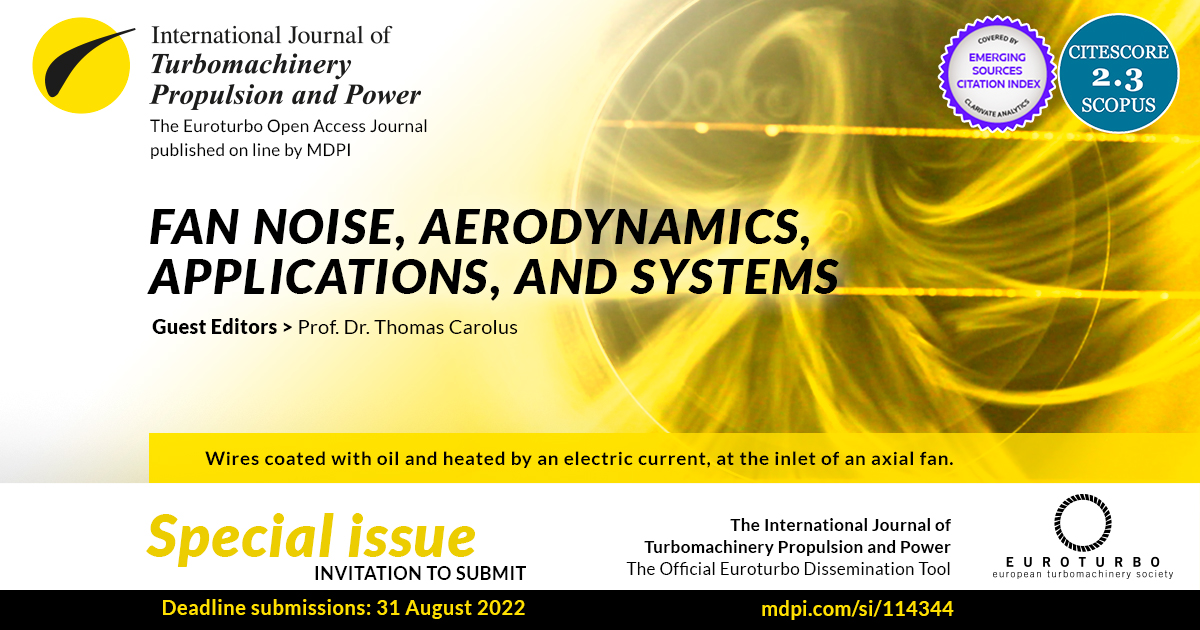Fan Noise, Aerodynamics, Applications and Systems
A special issue of International Journal of Turbomachinery, Propulsion and Power (ISSN 2504-186X).
Deadline for manuscript submissions: closed (31 October 2022) | Viewed by 56309

Special Issue Editor
2. Chair of Applied Fluid Mechanics and Turbomachinery, Universität Siegen, 57068 Siegen, Germany
Interests: aerodynamics and aeroacoustics of isothermal turbomachinery (incompressible gases); industrial fans; wind turbines; turbines for ocean energy harvesting (wave and tidal); dynamic models of systems
Special Issues, Collections and Topics in MDPI journals
Special Issue Information
Dear Colleagues,
The design of industrial fans has evolved to meet the ever-increasing demands for higher-efficiency machines, combined with the requirements for lower noise and high availability. Numerical simulation techniques are important parts of the aerodynamic and acoustic design process and are increasingly coupled to optimization methods. In addition, connectivity, the Internet of Things and digitalization in general open up new opportunities for the highly efficient, low-noise and safe operation of fans in complex systems.
The aim of this Special Issue is to promote the recent advances in fan technology and provide insights into the development and operation of industrial fans for a wide range of applications.
The paper submissions for this Special Issue are welcome to cover some of the following aspects, as well as other related topics:
- The development of analytical and computational aerodynamic methods;
- Emerging advanced fan design methodologies;
- The application of analytical and computational methods for fan analysis, design and optimization;
- Structural mechanical aspects (vibration, fatigue and flutter, preventive maintenance, condition monitoring, predictive maintenance);
- Experimental methods in fan analysis;
- Flow-induced and structure-borne fan noise;
- Methods of sound source localization in fans;
- Aeroacoustic models and computational (aero)acoustic methods;
- Psychoacoustics: product sound quality, perception of annoyance;
- Compliance with legislation and regulations;
- Connectivity technologies and digital services;
- Fan system effect.
Papers submitted for this Special Issue are also expected to come from the 4th International Conference FAN2022, scheduled to take place in June 2022 in Senlis, France.
Prof. Dr. Thomas Carolus
Guest Editor
Manuscript Submission Information
Manuscripts should be submitted online at www.mdpi.com by registering and logging in to this website. Once you are registered, click here to go to the submission form. Manuscripts can be submitted until the deadline. All submissions that pass pre-check are peer-reviewed. Accepted papers will be published continuously in the journal (as soon as accepted) and will be listed together on the special issue website. Research articles, review articles as well as short communications are invited. For planned papers, a title and short abstract (about 250 words) can be sent to the Editorial Office for assessment.
Submitted manuscripts should not have been published previously, nor be under consideration for publication elsewhere (except conference proceedings papers). All manuscripts are thoroughly refereed through a single-blind peer-review process. A guide for authors and other relevant information for submission of manuscripts is available on the Instructions for Authors page. International Journal of Turbomachinery, Propulsion and Power is an international peer-reviewed open access quarterly journal published by MDPI.
Please visit the Instructions for Authors page before submitting a manuscript. The Article Processing Charge (APC) for publication in this open access journal is 1000 CHF (Swiss Francs). Submitted papers should be well formatted and use good English. Authors may use MDPI's English editing service prior to publication or during author revisions.
Benefits of Publishing in a Special Issue
- Ease of navigation: Grouping papers by topic helps scholars navigate broad scope journals more efficiently.
- Greater discoverability: Special Issues support the reach and impact of scientific research. Articles in Special Issues are more discoverable and cited more frequently.
- Expansion of research network: Special Issues facilitate connections among authors, fostering scientific collaborations.
- External promotion: Articles in Special Issues are often promoted through the journal's social media, increasing their visibility.
- Reprint: MDPI Books provides the opportunity to republish successful Special Issues in book format, both online and in print.
Further information on MDPI's Special Issue policies can be found here.





